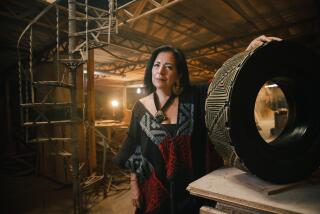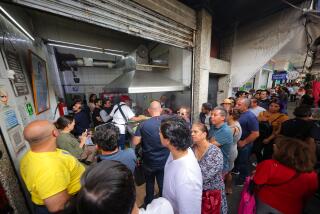Less-trod trails near San Miguel
When I arrived in San Miguel de Allende, in Guanajuato state in central Mexico last December, I felt as though I were home in Santa Fe, N.M., minus the central heating. San Miguel was picturesque, with scores of ethnic shops and artists.
And that was the problem. I craved the unfamiliar. So I ventured beyond San Miguel and found some places worth a detour.
Celaya
It took more than an hour to travel 32 miles south by bus from San Miguel, so I was disappointed to find an industrial city with a quarter of a million inhabitants.I walked from the bus station to the city center, where I discovered, to my delight, the works of Celaya architect Francisco Eduardo Tresguerras (1759-1833). Critical of the Mexican Baroque style of his time, Tresguerras became a master of Mexican neoclassicism.
The stately, beautiful Church of Carmen, built in the early 19th century, is considered his masterpiece. He also designed the facade, cupola and altars of the San Francisco Church. But it is his Water Tower that has become Celaya’s symbol. The huge silver globe, nicknamed the “Water Ball,” is modernistic, yet it harmonizes with the predominately Colonial buildings and churches of the city.
When I went to the city hall to get a map, I was struck by the towering historical figures in murals by celebrated Mexican artist Octavio Ocampo.
Seeing art often gives me an appetite, so I stopped in one of the city’s many candy stores to try cajeta, the caramels for which Celaya is known. They are sweet, smooth and sticky, and you can’t eat just one.
Apaseo el Alto
A chatty saleswoman in a Celaya shop asked me whether I knew about Apaseo el Alto, 17 miles south of the city. “It’s our best-kept secret,” she confided.I usually duck whenever anyone slings that cliché. In this case, the recommendation hit the mark. I hopped on a bus and an hour later got off in Apaseo el Alto, a town where many of the people I met were woodworkers. (There are about 500.)
Its main road is lined with furniture stores, artisan workshops and stores that sell religious and secular art, bookshelves, lamps and toys. It was a Saturday when I visited, and I saw families load beds, dressers, hand-painted tables and chairs into their pickups. One could, conceivably, furnish an entire house here. The quality ranges from rustic (as in “Are you kidding? Who would buy this?”) to fine (Read: “I have to have this and five others like it”).
One of my favorite places was Cardenas, the workshop of Leonardo Cardenas and his sons. Their specialty is religious art. When I was there, they were working on a 10-foot-tall crucifix for a church in Texas.
Cardenas has been a woodcarver for two dozen years, and his figures are sensitive, detailed and collectible. There are also decorative secular figures, animals and furniture.
The artists use about a dozen woods, and they are happy to tell you their names and specific properties. Prices start at about $20 for a small piece and run into the hundreds of dollars.
Agustín González
A woman in line at an automated teller machine in San Miguel was the impetus for a trip to the village of Agustín González, a short taxi ride from San Miguel. She told me about a group of 19 farmwomen who eke out a living by making and selling rugs.To get to Agustín González, we drove about 7 1/2 miles on the main road toward Guanajuato City, then an additional 6 1/4 miles past Presa Ignacio Allende lake. After a small sign that said “Precaución Zona Escolar,” Agustín González popped into view, across from a yellow school with turquoise doors. Beyond an iron gate, a dozen or so clucking chickens led me into the yard of Bonni Tovar.
Before and after working in their fields, the village women sit at their kitchen tables or sometimes outdoors, creating folk-style tapestries from recycled woolen clothing that has been cut into long strips. Their subject matter comes from what they see around them: mountains, cactuses, burros, flowers, rabbits, chickens and fish. Each rug is different, according to the artist’s inspiration and the recycled wool at her disposal. Prices range from $45 to $100.
Atotonilco
By taxi, Atotonilco is about half an hour away from San Miguel. I went there to see the mid-18th century Sanctuary of Atotonilco, which is sometimes called the Sistine Chapel of Mexico because of its murals by Miguel Antonio Martínez de Pocasangre, was built between 1742 and 1746.Every inch of the walls and ceiling is covered with folk renditions of the life of Christ. There are angels, saints, fruit, and flowers as well as grisly scenes of demonic figures writhing, bleeding and dying. The Chapel of the Holy Rosary has a carved, gold-covered wooden altar and paintings on Venetian mirrors.
The church also houses sculptures, and one of the most renowned is the Lord of the Column, depicting Jesus leaning on a column, all bloodied and bruised. Miracles have been attributed to the statue, including the lifting of an epidemic in San Miguel 175 years ago.
Nearby Atotonilco is the secluded Soledad Benedictine monastery, about 10 minutes away by taxi. The monastery, set in the beautiful desert landscape, is peaceful and offers the possibility for solitude.
Their Masses, held in a sparse, new chapel with whitewashed walls, a stone arch, wooden choir stalls and stained-glass windows that cast a cloak of colors over the choir area, include Gregorian chants.
Visitors can stay up to one week for about $25 a day. The price includes a room and three meals, which are taken in silence with the resident monks.
The gift shop has wood sculptures carved by the monks and by a local artist Juan Guerrero. There are animals, crosses, salad bowls and saints, with prices from $25 to $100.
Querétaro
It took a bus an hour and 20 minutes to travel the 42 miles from San Miguel, and after arriving in Querétaro I headed straight for the regional museum.Highlights include prehistoric finds (from as early as 7000 BC) and a room that reconstructs the life of the Chichimeca Indians before European contact.
An important display is the ornately carved table where the Treaty of Guadalupe Hidalgo was signed in 1848. Under the treaty, Mexico ceded the U.S. large chunks of the Southwest for $15 million.
Nearby, inside the Governor’s Palace, is the Casa de la Corregidora, the home of a heroine of the Mexican War for Independence, Josefa Ortiz de Domínguez. She alerted fellow conspirators of danger — depending on which story you believe — through a keyhole, by whispering through the walls or tapping on the floor. The result was that word reached Father Miguel Hidalgo, architect of Mexico’s independence, and led to his uttering the famous grito, or call to arms.
Then take a 10-minute walk to the graceful former Convent of Santa Cruz. Its long corridors lead to a little garden bearing the “tree of the crosses.” In 1697, Father Antonio Margil de Jesus placed a walking stick in the ground and, according to legend, a tree with three little thorns and a cross sprouted from it. The thorns look like the nails of the Crucifixion. The site has been a Franciscan seminary since 1645 and is home to 36 friars.
A historical highlight of the building is the room where Ferdinand Maximilian Joseph, emperor of Mexico, was imprisoned for three days in 1867 before he was executed.
Querétaro’s spookiest building is the Museo Casa de la Zacatecana, where a wealthy couple from Zacatecas came to live in 1869. The wife had her husband killed, then killed the murderer so he wouldn’t talk. Their bones, buried under the main floor of the house, are visible under glass. The wife was later murdered too, the story goes. Today, the house is a glorious museum, bedecked with 18th century art.
Dolores Hidalgo
Locals call the town Dolores, and many drive 27 miles northwest of San Miguel to browse its rows of ceramic shops. A friend told me Amora was among the best of them. Its shelves and floor are piled with raucously colored Mexican Talavera ware — pots, containers, urns, platters. Artisans work at the rear of the shop, each sitting in a white plastic chair, paintbrush in hand.Off the main square in the town center is the Church of Nuestra Señora de los Dolores, where Father Hidalgo uttered the call to arms.
From there it’s a two-minute walk to the Museum of National Independence, with its life-size statues of the padre, and murals that depict the tragic, violent conquest of Mexico by the Spanish.
The nearby Casa de Hidalgo museum is a pilgrimage site for Mexicans, because their hero lived there. It contains many of Hidalgo’s possessions — fragments of the pottery he taught natives to make, silkworms he tried to cultivate, a slingshot, spurs, original keys to the city, his bed.
I snacked at the Jardín, where vendors sell corn, tequila, cheese, beer, alfalfa and mole-flavored ice cream. Muy bueno. And I did the local thing and had carnitas at Vicente’s, a mound of pork served with guacamole, salsa, beans and gorditas.
Colonia
About 15 minutes away from San Miguel is the home of artist Rogelio Soltera. He worked for the Mexican phone company for 30 years, and in his free time made sculptures from colored phone wires. His peacocks, birds, frogs, spiders and elephants are masterfully crafted. Prices: $5 to about $50.*
(BEGIN TEXT OF INFOBOX)
The cradle of Mexican freedom
GETTING THERE:
From LAX, Continental flies nonstop to Querétaro, the nearest airport and 42 miles from San Miguel de Allende. Connecting flights (change of plane) are offered on Aeroméxico, United and Aero California. Restricted round-trip fares begin at $290.
GETTING AROUND:
Taxis cost about $15 an hour, but it’s better to negotiate in advance an all-inclusive price for each trip. The driver picks you up, drives you, waits for you and drives you back. The price depends on your bargaining skills.
Buses are comfortable, inexpensive and run frequently. They leave from the central station in San Miguel. Always try to get a direct bus, if possible. It will shave hours off your trips. One-way prices for most trips run $1.50 to $4.
Rental cars are available, but it’s better to take a cab or a bus.
TELEPHONES:
To call the numbers below from the U.S., dial 011 (the international dialing code), 52 (country code for Mexico) and the local number.
ATTRACTIONS:
Agustín Gonzáles rug makers, https://www.rughookproject.50megs.com or Charlotte Bell, (512) 447-2150 in the U.S. or 415-152-7548 in Mexico. Call before visiting.
Amora ceramic shop, Dolores Hidalgo; 418-185-9002.
Casa de la Corregidora in the Governor’s Palace, at the intersection of 5 de Mayo and Pasteur, Querétaro; 442-238-5000 (Spanish only). Open 8 a.m.-8 p.m. Mondays-Fridays; 8 a.m.-6 p.m. Sundays.
Museo Regional de Querétaro, 3 S. Corregidora, Querétaro; https://www.inah.gob.mx/muse2/htme/mure2201a.html . (Spanish only.) Open 10 a.m.-7 p.m. daily except Mondays. Free on Sundays, and about $3 at other times.
Museo Casa de la Zacatecana, 59 Independencia, Querétaro; 442-224-07-58, https://www.museolazacatecana.com . Open 10 a.m.-6 p.m. Tuesdays-Sundays. Closed Mondays.
Rogelio Soltera, the phone wire artist, lives at 16 Pera, Colonia; 415-152-4056.
Taller de Artesanias Cardenas, 504 Carret Panamericana, Apaseo el Alto; 413-166-0829.
TO LEARN MORE:
Mexico Tourism Board, (800) 446-3942 (for brochures) or (310) 282-9112, https://www.visitmexico.com .
— Judith Fein
More to Read
Sign up for The Wild
We’ll help you find the best places to hike, bike and run, as well as the perfect silent spots for meditation and yoga.
You may occasionally receive promotional content from the Los Angeles Times.






